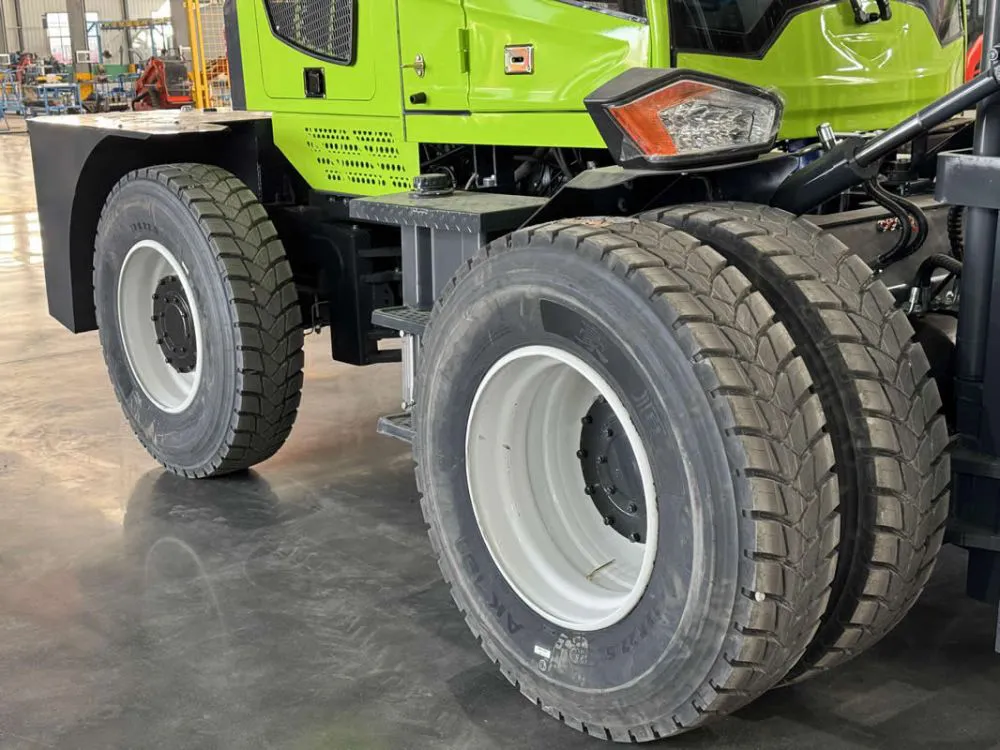Terrain forklifts are engineering vehicles specifically designed for complex terrain environments. They feature high mobility, strong load-bearing capacity, and adaptability to harsh working conditions, and are commonly found in construction sites, mines, and other similar settings. Terrain forklifts frequently operate in complex terrains such as ports and docks. If critical components (such as tracks, hydraulic systems, and braking devices) are not maintained in a timely manner, it may lead to operational malfunctions or equipment tipping over, causing safety accidents. Therefore, the maintenance and care of terrain forklifts is crucial to ensure operational safety, extend the forklift's lifespan, improve work efficiency, and reduce forklift maintenance costs. This guide will provide a relevant introduction to the maintenance and care of terrain forklifts.

The basic structure of a terrain forklift includes components such as the chassis, tires, drive system, and hydraulic system. Terrain forklifts, through enhanced power, transmission, and chassis design, adapt to complex environments such as mud and sand. Their core principle is the combination of a hydraulic system and all-wheel drive to achieve efficient and stable cargo handling while maintaining stability.
2.1 Cleaning and Inspection
Regularly clean the forklift, especially the tires, drive shafts, and hydraulic system, to prevent the accumulation of mud and gravel. Inspect the exterior of the forklift body to ensure there are no cracks or damage.
After daily operations, remove dirt, focusing on cleaning the fork carriage, mast slides, and battery terminals; check for fork cracks/deformation, chain tension, and the tightness of all components, such as wheel bolts and brake connectors.
2.2 Pre-Operation Inspection
Before starting, walk around the forklift to check for external deformation, leaks, and tire pressure/wear (replace tires with tread exceeding limits); test braking resistance, hydraulic lifting smoothness, and instrument indicator status, ensuring the passageway is free of debris and meets turning radius requirements.
2.3 Lubrication System
Introduce lubricating oil, lubrication points, and lubrication cycles. The impact of lubrication on long-term operation of terrain-fighting forklifts.
2.4 Tire and Suspension System Inspection
Tire wear inspection and replacement recommendations. Regularly inspect the suspension system to ensure the forklift can operate stably on uneven terrain. 2.5 Braking and Steering Systems
The braking system needs to be kept clean. Check the brake fluid level and replenish it as needed. Replace brake pads immediately if they are worn beyond the recommended level. Regularly check the steering system for steering gear clearance and component wear, and adjust or replace any faulty parts.

3.1 Engine Maintenance
Change the lubricating oil and check the air filter. Check and maintain the engine cooling system to prevent overheating.
Change the oil every 50-200 hours of operation (depending on intensity), and replace the oil filter at the same time. Diesel engine oil usage is 6.5-7.5 liters (11.8-ton class) or 35-40 liters (23.8-ton class).
3.2 Hydraulic System
Hydraulic oil change intervals and checks. Check hydraulic lines to prevent leaks or aging lines.
Regularly check cleanliness and change the oil every 600 hours. Use No. 32 hydraulic oil in extremely cold environments, and 40-50 liters (23.8-ton class) in standard environments. Use No. 6 hydraulic transmission oil, 8 liters (23.8-ton class).
3.3 Drive System
Inspect and maintain the drive battery (electric forklift) or fuel system (internal combustion engine forklift). Inspect the transmission system, such as the lubrication and adjustment of the gearbox and differential.
3.4 Replacement of Wear Parts
Clean the air filter every 50 hours and replace it every 200 hours; replace the fuel filter and hydraulic return filter regularly. Check the brake fluid every 200 hours, use mineral oil-based brake fluid (anti-vapor lock for high-altitude environments) and maintain a capacity of 1.5 liters.
Ensure all safety devices of the forklift (such as the braking system, alarm system, etc.) are functioning properly. Troubleshoot common faults and provide solutions.
Regularly check for aging/loose wiring, clean the battery surface of dirt, maintain electrolyte concentration, and tighten wiring terminals to prevent corrosion.
5.1 High-Altitude Operation
Adjust the ignition timing advance (2°-3° earlier than at sea level), use mineral oil-based brake fluid and replace oil-resistant brake cups; lower tire pressure to prevent blowouts, and improve the cooling system's sealing.
5.2 Low-Temperature Operation
Drain coolant when the temperature is below 0°C; remove the battery compartment for freeze protection when the temperature is below -15°C; preheat the engine before starting and use low-pour-point hydraulic fluid.
5.3 Slopes and Narrow Spaces
Tilt the forks forward to prevent backward slippage when going uphill; reverse when going downhill; use a three-point steering system to observe blind spots in narrow passages, and never force your way through.
Emphasize the importance of regular inspections and proactive maintenance to avoid sudden malfunctions.
For terrain forklifts, terrain and environmental factors have a particularly significant impact on the equipment; therefore, maintenance plans must be adjusted according to the operating environment.
Standardized maintenance and upkeep of terrain forklifts can maintain efficient and safe operation, thereby improving work efficiency and reducing maintenance costs.